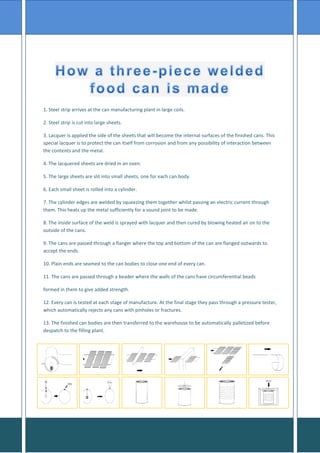
Manufacturing 3-Piece Welded Food Cans
- 1. 1. Steel strip arrives at the can manufacturing plant in large coils. 2. Steel strip is cut into large sheets. 3. Lacquer is applied the side of the sheets that will become the internal surfaces of the finished cans. This special lacquer is to protect the can itself from corrosion and from any possibility of interaction between the contents and the metal. 4. The lacquered sheets are dried in an oven. 5. The large sheets are slit into small sheets, one for each can body. 6. Each small sheet is rolled into a cylinder. 7. The cylinder edges are welded by squeezing them together whilst passing an electric current through them. This heats up the metal sufficiently for a sound joint to be made. 8. The inside surface of the weld is sprayed with lacquer and then cured by blowing heated air on to the outside of the cans. 9. The cans are passed through a flanger where the top and bottom of the can are flanged outwards to accept the ends. 10. Plain ends are seamed to the can bodies to close one end of every can. 11. The cans are passed through a beader where the walls of the cans have circumferential beads formed in them to give added strength. 12. Every can is tested at each stage of manufacture. At the final stage they pass through a pressure tester, which automatically rejects any cans with pinholes or fractures. 13. The finished can bodies are then transferred to the warehouse to be automatically palletized before despatch to the filling plant.
- 2. How a three-piece welded food can is made Head of Regional Quality Management fadi_daghlas@yahoo.com How a three-piece welded food can is made 1. Steel strip arrives at the can manufacturing plant in large coils. 2. Steel strip is cut into large sheets.
- 3. How a three-piece welded food can is made Head of Regional Quality Management fadi_daghlas@yahoo.com 3. Lacquer is applied to the side of the sheets that will become the internal surfaces of the finished cans. This special lacquer is to protect the can itself from corrosion and from any possibility of interaction between the contents and the metal. 4. The lacquered sheets are dried in an oven. 5. The large sheets are slit into small sheets, one for each can body. .
- 4. How a three-piece welded food can is made Head of Regional Quality Management fadi_daghlas@yahoo.com 6. Each small sheet is rolled into a cylinder. 7. The cylinder edges are welded by squeezing them together whilst passing an electric current through them. This heats up the metal sufficiently for a sound joint to be made.
- 5. How a three-piece welded food can is made Head of Regional Quality Management fadi_daghlas@yahoo.com 8. The inside surface of the weld is sprayed with lacquer and then cured by blowing heated air on to the outside of the cans. 9. The cans are passed through a flanger where the top and bottom of the can are flanged outwards to accept the ends.
- 6. How a three-piece welded food can is made Head of Regional Quality Management fadi_daghlas@yahoo.com 10. Plain ends are seamed to the can bodies to close one end of every can. 11. The cans are passed through a beader where the walls of the cans have circumferential beads formed in them to give added strength. 12. Every can is tested at each stage of manufacture. At the final stage they pass through a pressure tester, which automatically rejects any cans with pinholes or fractures.
- 7. How a three-piece welded food can is made Head of Regional Quality Management fadi_daghlas@yahoo.com 13. The finished can bodies are then transferred to the warehouse to be automatically palletized before despatch to the filling plant.
